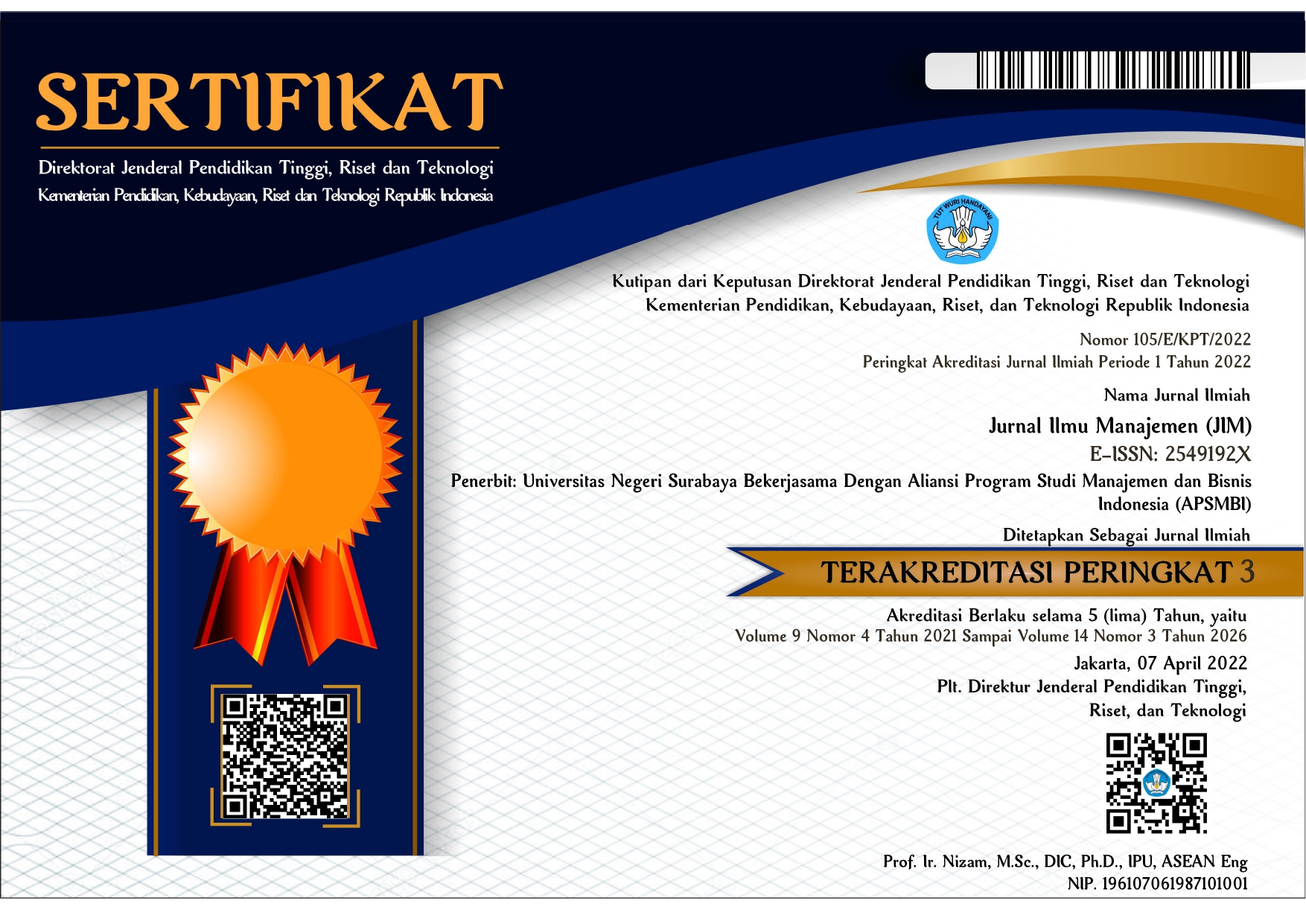Analisis Tingkat Literasi Keuangan Mahasiswa Perguruan Tinggi Negeri
DOI:
https://doi.org/10.26740/jim.v10n2.p545-553Keywords:
age, financial literacy, gender, personal financeAbstract
This research aims to analyze the level of financial literacy of students of the Economic and Business Faculty. This research was designed as quantitative descriptive research. This research used a financial literacy test questionnaire to collect responses through purposive sampling. The result shows that the average financial literacy of students is in the high financial literacy category. Based on the outcome, students' financial literacy is influenced by parents' education. There is no significant influence of age and gender on students' financial literacy levels. Older students do not necessarily understand financial literacy, and younger students do not necessarily misunderstand financial literacy. Men and women students have the same perspective about financial literacy in this period. With this finding, students who receive or do not receive education or information about financial knowledge from their parents can dig deeper into financial concepts through formal and non-formal education, such as through universities, social media, and study group discussions. A high level of financial literacy can affect many social aspects of society, which are becoming more developed, and financial perspectives are becoming more modern.
References
Adipradana, A. A. (2021). Analisis Tingkat Literasi Keuangan Mahasiswa Akuntansi Fakultas Ekonomi Dan Bisnis Universitas Brawijaya Dan Faktor-Faktor Yang Memengaruhinya. Jurnal Ilmiah Mahasiswa Fakultas Ekonomi dan Bisnis, 10(1), 12-26. https://jimfeb.ub.ac.id/index.php/jimfeb/article/view/7765/6691#
Ajzen, I. (1991). The Theory of Planned Behavior. Health Communication, 50(2), 179-211. https://doi.org/10.1080/10410236.2018.1493416
BPS Surabaya. (2021). Pertumbuhan Ekonomi Kota Surabaya 2020. Badan Pusat Statistik Kota Surabaya: (https://surabayakota.bps.go.id/pressrelease/2021/03/18/236/pertumbuhan-ekonomi--kota-surabaya-2020.html, diakses 11 Juni2021)
Bryce, J. (2007). Financial Literacy of College Students: Parental and Peer Influences: Blacksburg: Virginia Polytechnic Institute and State University
Garman, T., & Forgue, R. (2014). Personal Finance: Canada. Cengage Learning
Idris, M. (2021). Apa yang Dimaksud dengan Investasi ?. Kompas.com. (https://money.kompas.com/read/2021/06/04/155444726/apa-yang-dimaksud-dengan-investasi?page=all, diakses 11 Juni 2021)
Irman, M. (2018). Analisis Faktor-Faktor yang Memengaruhi Literasi Keuangan di Kalangan Mahasiswa Universitas Muhammadiyah Riau (Umri) Pekanbaru. Journal of Economic Business and Accounting (COSTING), 1(2), 180-197 https://doi.org/10.31539/costing.v1i2.205
Kautsar, A., & Asandimitra, N. (2019). Financial Knowledge as Youth Preneur Success Factor. Jounal of Social and Development Sciences, 10(2), 26-32. https://doi.org/10.22610/jsds.v10i2(S).2906
Kusumawardhani, R., Cahyani, P. D., & Ningrum, N. K. (2020). Analisis Perbedaan Tingkat Literasi Keuangan antara Mahasiswa Fakultas Ekonomi dan Mahasiswa Fakultas Non-Ekonomi. Mix Jurnal Ilmiah Manajemen, 10(1), 15. https://doi.org/10.22441/mix.2020.v10i1.002
Lantara, I. W. N., & Kartini, N. K. R. (2015). Financial Literacy Among University Students: Empirical Evidence from Indonesia. Journal of Indonesian Economy and Business, 30(3), 247-256. https://doi.org/10.22146/jieb.10314
Nababan, D., & Sadalia, I. (2013). Analisis Personal Financial Literacy dan Financial Behavior Mahasiswa Strata I Fakultas Ekonomi Universitas Sumatera Utara. Jurnal Ilmiah Mahasiswa, 1(1), 1-16.
Nurulhuda, E. S., & Lutfiati, A. (2020). Analisis Faktor-Faktor yang Memengaruhi Literasi Keuangan. KINERJA Jurnal Ekonomi dan Bisnis, 2(2), 111-134. http://repositori.uin-alauddin.ac.id/id/eprint/19857
OJK. (2019). Survei Nasional Literasi dan Inklusi Keuangan 2019. Otoritas Jasa Keuangan: (https://www.ojk.go.id/id/berita-dan-kegiatan/publikasi/Pages/Survei-Nasional-Literasi-dan-Inklusi-Keuangan-2019.aspx, diakses 11 Juni 2021)
Pddikti kemendikbud (2021). Statistik Perguruan Tinggi. pddikti.kemdikbud.go.id (https://pddikti.kemdikbud.go.id/data_pt/Q0IxMTU0QjQtMTBCQS00NzEyLUI5MTYtMzYwNTFCQTdDMzJG, diakses 10 Desember 2021)
Sabri, M. F., & MacDonald, M. (2010). Savings Behavior and Financial Problems Among College Students: The Role of Financial Literacy in Malaysia. Crosscultural Communication, 6(3), 103-110. http://www.cscanada.net/index.php/ccc/article/view/1468
Widayati, I. (2012). Faktor-Fktor yang Memengaruhi Literasi Finansial Mahasiswa Fakultas Ekonomi dan Bisnis Universitas Brawijaya. Jurnal Akuntansi dan Pendidikan, 1(1), 89-99.
Yushita, A. N. (2017). Pentingnya Literasi Keuangan bagi Pengelolaan Keuangan Pribadi. Nominal, Barometer Riset Akuntansi Dan Manajemen, 6(1), 11-26. https://doi.org/10.21831/nominal.v6i1.14330
Downloads
Published
How to Cite
Issue
Section
License

This work is licensed under a Creative Commons Attribution-NonCommercial 4.0 International License.
 Abstract views: 1087
,
Abstract views: 1087
, PDF Downloads: 3164
PDF Downloads: 3164










